Recently our partners from Push Operations hosted a webinar featuring Bruce Macklin, sales engineer from the TouchBistro team. During the webinar, Bruce helped us uncover tactical tips to optimize restaurant profits through technology and people management solutions. Here, you’ll find a synopsis of what he shared.
During the webinar Bruce covered:
- How to leverage your POS to save on operating costs
- Using integrations to improve operating costs
- Strategies to optimize labor costs with analytics
- FOH and BOH workforce management tips
From his humble beginnings starting out in the dish pit, Bruce worked his way through kitchen service and bartending to his current position with TouchBistro – accumulating over 20 years of wisdom along the way.
Bruce’s extensive knowledge and first-hand experience in the restaurant industry illuminated some key strategies for streamlining businesses and optimizing operations with software integration systems. The value of POS integration cannot be overstated: saving time and money through simple efficiencies you wish you knew about sooner!
1. How to leverage your POS through software to save on operating costs.
Cost of Labor
Operating costs vary widely in how they present themselves and can often be disguised and hard to manually analyze. The TouchBistro POS provides a very unique service called a “Current Snapshot Report,” which works by capturing the labor hours and cost of labor for both the front and back of house positions. Additionally, it records your total sales and expresses this as a ratio to create an end-of-day forecast, which you can then view at any point in time to adjust your management accordingly. This is an excellent way to keep your finger on the pulse of your business and modernize operations.
Forecasting
Labor forecasting can be defined as the method for predicting necessary hours of labor for future business operations, in order to prevent management overstaffing or understaffing and avoid unnecessary costs.
Restaurant scheduling software allows you to view your current labor forecast versus your sales, in real-time. This saves you a huge amount of time when conducting your business and can be essential when making relevant adjustments to schedules that demonstrate the flexibility and responsiveness you need for your bistro to succeed.
Bruce shared that by using Push, you are able to create a suggested schedule for the following week based on your current week, and factors in extraneous events like changes in the weather, to ensure your operating costs are streamlined and efficient, helping you optimize restaurant profits.
Floor Plan Efficiencies
Using floor plan templates generated by your integration software helps you make adjustments for how busy the service period is predicted to be, and creates easy-to-use color-coded sections. This restaurant table management can ensure a smooth guest experience and save you time and money through efficient organization.
For example, if the service period isn’t predicted to be as busy as usual, you might consider reducing the number of color-coded table sections and, as a result, the number of rostered staff members. Having staff cover larger floor sections will reduce the total cost of labor and help you avoid unnecessary operating costs, ultimately optimizing profits.
Tableside POS
During our chat, Bruce reminisced with us about the old-school POS system – big and clunky – taking up space for potential tables, and costing you money through additional labor. He advises the adoption of tableside service by going mobile, resulting in even more savings through cutting out the middleman and reducing your total cost of labor.
By using GQ codes or hand-held POS systems, you’re modernizing your business to adjust to the future climate of the service industry, reaping benefits such as creating a smoother guest experience, freeing up your staff, and improving table turn times.
2. Using integrations to improve operating costs.
Time Theft
An employee clocking in for hours they didn’t work is considered time theft and can add up to a significant loss of your restaurant profits if not managed and effectively controlled. Using integration software can help you streamline your operation, and can prevent buddy punching (when a coworker clocks in for someone else in their absence).
Time tracking software is a great way of providing a flexible solution to manage your business and streamline labor tracking through real-time reporting, preventing time theft and buddy punching. It presents a true running labor ratio throughout your operation that assists you in making informed choices while saving time and avoiding unnecessary operating costs. The advanced facial recognition software Push utilizes for employee sign-ins and outs, alerts you when schedules and clock-ins misalign so that business owners can adjust and approve of them accordingly. This can ensure no one’s clocking in for anyone else, and everyone is paid appropriately for the correct role they sign into at the start of their shift.
Bruce suggests using integrations to set up grace periods for people who show up early and take their time after clocking on before they get onto the floor – this can control and tighten when people clock in according to schedules, ultimately optimizing restaurant profits.
Payroll/Reports
A great benefit to using restaurant payroll software that integrates with other restaurant software is the time efficiency factor, thanks to smart automations, calculations, and data transfers. Restaurant payroll software has the ability to track across different locations and adjust pay rates accordingly. Push Payroll provides you with graphs of tracked sales and labor costs, affording you the opportunity to analyze trends in real-time allowing you to manage and intervene as necessary. Bruce highlights the value of this real-time data tracking, as you don’t want to be waiting for fortnightly reports and responding with reactionary measures, leaving you feeling overwhelmed and unequipped.
With TouchBistro, you can create cost of goods sold analytics through menu reports, as well as building recipe inventories to manage operating costs effectively. This intelligent POS integration is key to optimizing restaurant profits when looking at forecasting and your labor-revenue percentage.
Labor Scheduling Forecasts
A major strategy for optimizing restaurant profits is regular scrutiny of your labor cost percentage reports. Brice recommends maintaining operations to ensure the percentage stays below 30%. He shares two great solutions with us, depending on the specific circumstances of the restaurant at the time:
- Eliminate staff (a good temporary solution, but not always ideal)
OR
- Increase revenue
Increasing revenue could mean sending a message out through loyalty apps to your bigger spenders for a spontaneous promotion. Maybe you decide to do half-price bottles of wine, but only from 6-7:30 pm. Having real-time data analytics available allows you to forecast your labor needs across the day and adjust your operations accordingly to bring down your labor percentage, helping optimize restaurant profits.
Labor Adjustments and Payroll Integrations
Using Push Operations to manage your labor adjustments and payroll integrations can make such tedious tasks reliable and cost and time efficient, revolutionizing your business operations. The cost of integration with Push is highly flexible to the services you desire – you can have a part or the whole of the system, depending on the needs of your restaurant.
In our webinar, Bruce draws attention to the very strict labor law requirements within California, where you’re required to clock in and out for breaks, and to state whether it’s paid or unpaid. All those details considered, compliance can become difficult and time consuming when done manually. Push is designed to comply with these laws and can streamline this process for you, so it becomes much easier to optimize the way you run your business.
3. Strategies to optimize labor costs with analytics.
Contests/Incentives to Optimize Labor
A great way of increasing your revenue to lower your labor percentage is to employ contests and incentives that motivate your team through competition. For example, if Bruce has sold more of Chuck’s Burger than any other server on the floor, he wins a special prize! He’ll be bragging and engaging with his team members positively to incentivize them to challenge him, bringing in extra sales revenue and optimizing labor.
4. FOH & BOH management tips to improve operating costs.
Using Software to Streamline Your Services
POS integration can provide useful data on the online ordering services you’re using, and looking at these FOH & BOH key performance indicators is imperative to improving your service, as well as making your operations more cost efficient. This data tracking enables you to see when you get the most orders and allows you to prepare in advance for the rush – instead of overwhelming the kitchen and having to shut down online deliveries.
With TouchBistro’s Menu Management software, you’re able to boost revenue by managing takeout orders with ease and promoting upselling through color-coded menus. It also saves you time with its easy-to-use menu building, as well as its built-in inventory management feature, which alerts you when you need to reorder supplies. To improve your operating costs and optimize restaurant profits, the utilization of software can allow people to order in advance, helping you manage and prepare for that higher volume.
In Conclusion
Bruce covered some crucial information in our webinar that’s essential for anyone looking to optimize restaurant profits through technological solutions and excellent workforce management. Using his extensive industry knowledge and experience, he highlighted how POS integration can provide streamlined resolutions to improve your business operation, such as looking at the cost of labor analytics, labor forecasting, floor plan efficiencies, and tableside POS.
He enlightened us on where businesses are running inefficiently and losing money to things like time theft, delayed and outdated reports, as well as oversights in labor scheduling adjustments. Understanding the importance of labor percentage is key to your business’ success, and thanks to Bruce, we’ve even been given some strategies for incentivizing workers to improve labor efficiency, and increasing revenue to keep your labor percentage below 30% – all working together to optimize restaurant profits.
Catch the webinar replay!
Play the video above or click here to listen to the full webinar.
About the Solutions:
TouchBistro is an all-in-one Restaurant Management System that pairs innovative restaurant technology with an unparalleled dedication to customer support and success. Having powered more than 29,000 businesses in over 100 countries, TouchBistro provides essential FOH, BOH, and customer engagement solutions on one easy-to-use platform to streamline and simplify operations, increase sales and deliver a great guest experience.
Push Operations helps restaurant owners grow and scale operations by simplifying HR, payroll, and workforce management tasks all through our convenient and accessible platform and integrates leading restaurant POS systems like TouchBistro by offering an end-to-end solution that gives transparency on things like labor insights and sales versus labor forecasting.





